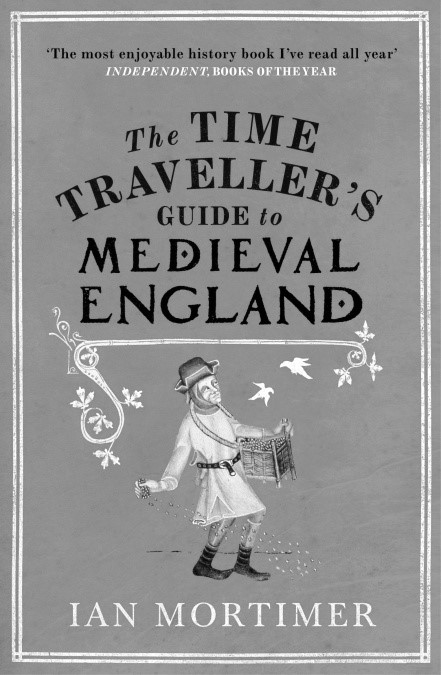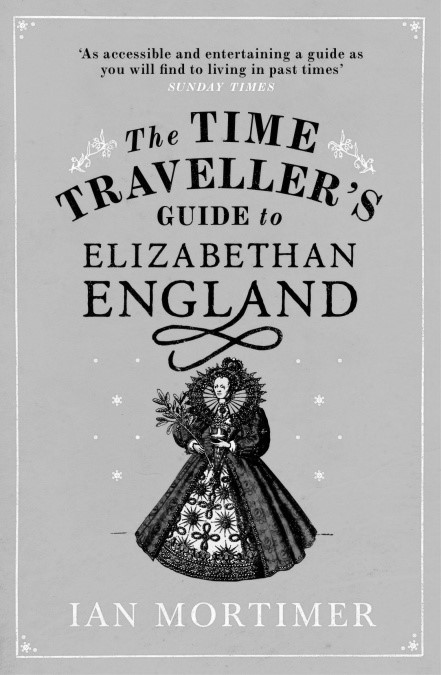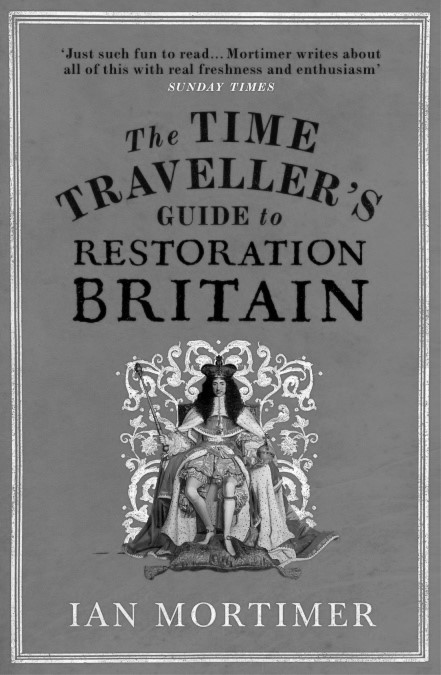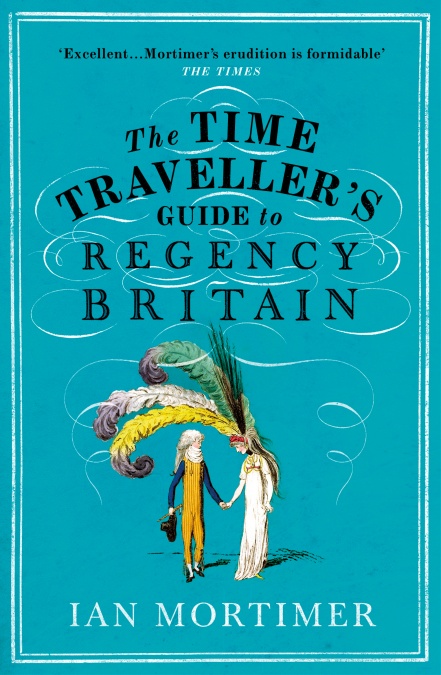|
The Time Traveller's Guide to Introduction On Thursday 28 January 1790, the Reverend Thomas Puddicombe brushed the dirt from his hands and returned to his vicarage in the village of Branscombe, on the South Devon coast. The ceremony at which he had just officiated was, in many ways, a routine one. The words of the burial service were time-honoured and familiar; the sombre dress of those attending was prescribed by custom, their grief unsurprising. No less ordinary was his final duty that day, which was to record the date and the name of the deceased in the parish register. However, when he sat down at his desk and dipped his quill in the ink, he did not write an ordinary entry. He added the cause of death, as follows: 'White, John, aged 77. This man lost his life by a very trifling accident: paring his toenail with a penknife a little too close, so as just to draw blood: it rankled, and a mortification coming on, carried him off in a few days. Anyone who is familiar with English parish registers will be surprised at this level of detail. But Mr Puddicombe often wrote something about the manner of his parishioners' deaths. After Joseph Hooke, the thirteen-year-old son of a local farmer, met with an accident in 1803, the vicar felt obliged to record that the lad 'was run away with by a spirited horse, fell at the corner of the lane by Hangman's Stone; was dragged the distance of half a mile and found dead in the lane a little way above Higher Watercombe'. And when Jane Toulmin, a twenty-five-year-old woman, drowned herself in May 1798, he wrote three-quarters of a page about the last two days of her life, ending with a description of how: 'Before she quitted her sister's house, she put out what money she had, and left it in her bedroom and, in this state, without a sixpence in her pocket, she wandered about till Tuesday morning, the day on which, it is to be feared, she put an end to her existence. She was seen at Beer walking very fast up Common Lane between three and four o'clock; and about a quarter past 5 o'clock she was discovered in the water by one John Parrett, a carpenter.' When you read such passages, the world they create doesn't quite chime with our picture of the Regency - the fine houses, the costumes and the carriages. But, of course, country churchyards, horse-riding accidents and young women in a state of distress are also part of the period. And every detailed entry in Thomas Puddicombe's burial register raises questions. Was it usual for people to pare their toenails with a penknife in 1790? Were riding accidents like Joseph Hooke's common? As for poor Jane Toulmin, did people in the 1790s have an understanding of mental illness? You won't find the answers in the pages of a Jane Austen novel: yet they are as revealing of the real world in which she lived as the complex interplay of the characters in her books. Mr Puddicombe's descriptive burial-register entries abruptly come to an end in 1812. From then on, he was officially prevented from composing them. This was not because he had done anything wrong but because in that year the government imposed a printed form for recording the details of a burial. Each page consisted of a series of boxes in which the officiating minister was required to write the deceased's name, age, place of residence and date of burial - and nothing else. This shift, from effusive individualism to government-imposed standardisation, is indicative of wider changes. For many people in the 1860s the Regency seemed like the last age of true freedom before the regulation of society started in earnest. The Great Reform Act of 1832 signalled the beginning of the end of the political domination of the aristocracy and landed gentry. In 1833, the Factory Act set limits on the number of hours that children could work each day. That same year, slavery was abolished throughout the British colonies. In 1834 the gibbeting of murderers came to an end. The once-common sight of public executions became rare as abolitionists argued against the death penalty with increasing success. Cruel sports such as cockfighting and bear-baiting were outlawed in 1835. The compulsory state registration of births, marriages and deaths began in 1838. The standardisation of the screw thread by Joseph Whitworth was introduced in 1841, paving the way for mass production. From the mid-1840s, the telegraph enabled messages to be sent instantly over long distances. Trains replaced the regular mail coaches and stagecoaches, rendering highwaymen a thing of the past. Photography started to rival painting as the most common means of recording scenes and portrait images. On top of all these things, a new morality swept across society in the early Victorian period, limiting people's freedom of behaviour. Attitudes to adultery, gambling and unpaid debts especially hardened. You can see why those who looked back from the 1860s saw their Regency forebears as an unfettered and wild bunch, among whom Lord Byron was not the only man who was 'mad, bad and dangerous to know'. It had been a time when gentlemen and ladies, beggars and clergymen, soldiers and tramps, employers and courtesans could all pretty much behave as they saw fit, in a world that gleamed with gold and heroism, drink and sex, excitement and opportunity. Our own impressions of the years from 1789 to 1830 are not that different. Today, the period is still seen as a time of exuberance and unchecked bad behaviour. Indeed, we consider the conduct of the upper classes to have been particularly immoral, on account of the self-indulgence of the Prince Regent and his companions. The inscription on the Ancient Greek temple of Apollo at Delphi might have instructed the wise to do 'nothing in excess' but the classically educated English upper classes appear to have taken it as a challenge - to do everything in excess. Hence you have a royal court of rakes, dandies and hellhounds, all stuffing themselves with rich food, drinking huge amounts of port and gambling away fortunes until the early hours, at which point they would either go to bed with their mistresses or collapse untidily around their mansions - 'snoring in boots on the sofas', as Princess Caroline put it - before waking up to escort their hangovers down to the Houses of Parliament, where they would make speeches about the future of the country. To the ranks of these privileged scoundrels you can add a wide range of other dubious characters: dashing highwaymen, cunning smugglers, gentlemen pugilists and political duellists of all ranks and persuasions. In short, for many of us today the Regency period simply was the Age of Excess. Sandwiched between the slightly dull elegance of the eighteenth century and the prim moral superiority of the early Victorians, it all seems licentious, naughty, dazzling, dangerous, shocking, offensive and yet, oh, so entertaining and attractive. Hang on a minute, you might say: was this not also the period in which John Nash laid out Regent Street and Regent's Park in London, with their magnificent houses? Was this not the time when George Stephenson built his pioneering steam engines and Michael Faraday developed the electric motor? And have I forgotten that the early nineteenth century saw the establishment of the National Gallery, the decipherment of hieroglyphs and the installation of the Elgin Marbles in the British Museum? Are not the riotousness of the period and these cultural refinements at odds? They are indeed. And you could go further with this line of argument. With regard to the new houses up and down the country, it was precisely in these stately homes, urban squares and crescents that the most riotous people lived. Think of the landscaped gardens of the great houses laid out by Humphry Repton and Lancelot 'Capability' Brown. Picture their furniture, made from designs by George Hepplewhite and Thomas Sheraton. Remember the rugs, the paintings, the ornaments, the sculptures, the porcelain, the musical instruments. Many still consider Regency design to be the height of good taste and elegance. To think that it was also associated with the rakes, reprobates and riotous members of society is more than a little surprising. But herein lies our key to understanding the time. It is only when you find the apparent contradictions in a subject that you begin to appreciate it fully. As the wealthy seemed determined to do everything in excess, it is hardly surprising that their exuberance extended also to spending money, as they sought to demonstrate their place in society by building ever more magnificent houses and commissioning ever finer furniture. As for the intellectual and cultural innovations of the period, can you be surprised that artists and manufacturers went to such extraordinary lengths to please their patrons when there were enormous financial rewards on offer? With the upper classes determined to spend as much money as they could, they created an environment in which the most brilliant artists, architects, scientists and innovators were able to flourish, thereby leaving the impression that this was a golden age. Although the labourers who helped create those fortunes saw only modest improvements in their own living standards and rose up in protest on more than one occasion, that is another matter. After two hundred years, the riots are much less obvious to the modern eye than the splendid, well-furnished houses that the wealthy left behind. The tensions in Regency society were not limited to the contrasts of privilege versus penury, and individualism versus state control. They were also the result of profound social and economic changes. The population of Britain was increasing at a faster rate than it had done at any point in history (and faster than it has done ever since, for that matter). It was also rapidly becoming more urban. Herein we have another contradiction. Did the artists of the time celebrate the growth of the industrial towns? No. They did exactly the opposite: they celebrated the natural world that was being lost. John Constable's most famous painting, The Hay Wain, completed in 1821, shows two men chatting leisurely on a cart in the middle of a river. They seem to have all the time in the world, apparently unconcerned about the changes around them. Theirs is an environment shaped by the rhythm of the seasons and a river that will always flow. No columns of smoke cloud the sky; no urban back yards confine their world. John Clare's poetry similarly harks back to a rural idyll, surrounded only by nature and the village life of his childhood. Where artists and poets directly addressed the forces reshaping the landscape, they hardly ever did so in a positive, glorifying way. William Blake's 'dark satanic mills' belched fumes over 'England's green and pleasant land': there was nothing here to delight an artist. The old biblical image of fire coming down from Heaven had been reversed: now the fires reached up to Heaven from Earth. Perhaps the most brilliant artistic evocations of the era are to be found in music, most notably in the universally popular works of Ludwig van Beethoven, but even here we find a cultural conflict. Beethoven's famous Fifth Symphony thundered out like a colossal engine in London for the first time on 15 April 1816. It is difficult to reconcile the majestic, strident, four-note theme with the delicate sensitivities of Jane Austen's Persuasion, written that same year. It is a truism to say that the reality of the past is always more complex and varied than our image of it. In this case the very word 'Regency', with all its grand connotations, is part of the problem: it makes everything sound luxurious. Victorian romantics looking back to what seemed a time of greater individual freedom tended not to see how few opportunities were open to Regency labourers and their families in the expanding industrial towns. When we look at the handsome coins and banknotes from the period it is a salutary thought that most working people never handled gold or paper money. Mention Nelson's navy to them and they would have thought of pressgangs and the conditions aboard those heaving wooden ships, the ear-splitting explosions of cannon and shocks of splintered wood during battle, the cold wind whistling through the rigging and the prospect of a watery grave. But say the words 'Nelson's navy' to a late-nineteenth century Englishman and he would probably have pictured a print showing the dramatic moment of Nelson's death aboard the Victory. The lesson to us is obvious. In order to understand this extraordinarily varied and contradictory period we must detach ourselves from past attempts to romanticise it or to celebrate it as the last age of 'true freedom' or Britain in its bucolic bliss. We must do more than simply look at the waters of time passing from the riverbank: we must dive in and immerse ourselves. 'Immersing ourselves' is easier said than done, however. How do we go about it? The answer lies in accessing sufficient evidence and, just as importantly, in understanding its context and relevance. This is not difficult for the Regency: huge numbers of documents, books, images, objects and buildings survive. One particularly useful text in this respect is Letters from England by Don Manuel Alvarez Espriella, first published in three volumes in 1807. This is purportedly a travel guide to England in the years 1802-3 by a Spanish gentleman but is actually by the English poet laureate Robert Southey: its conceit is thus not so different from this present book and, being composed by a knowledgeable contemporary, I have used it as a general guide. However, gathering and assessing evidence only gets us so far. To assume that it is synonymous with reconstructing the past is like thinking that, if you could reconnect all the bones, sinews and muscles of Admiral Nelson's body, he would somehow walk and talk again. While analysing historical information is a science, reconstructing the past in a meaningful way is an art. We need to draw on our own experiences to blow life into the evidence, and the way to do this is to focus not on the documents, paintings and buildings themselves but on the actions, needs and ideas that lie behind them. If, as a historian, you regard a physical document as the limit of the knowable truth, without trying to imagine what it was that made people cry, scream and pray, then you are simply undertaking an academic exercise. Don't get me wrong, academic exercises are hugely valuable: they are essential for a proper understanding of the past. But they have their limitations. Nelson's bones could tell us many things about the man but not necessarily what we most want to know. Indeed, you would never guess just from a skeleton that a human being could smile. Herein lies the essence of a time traveller's guide. You can see the life that lies behind the evidence, complete with all its contradictions. How should you cut your toenails in 1790 if you want to avoid dying of blood poisoning? How can you get help if a member of your family is suffering from a mental disorder in 1798? How are you going to travel around safely? What are you going to wear; where might you stay; what should you eat; and what might you do for fun? While I cannot predict what Jane Austen might make of you, if you were to knock on the door of number 4 Sydney Place, Bath, in 1803, I can suggest what you would see if you visited the town in that year, and what you might make of the standard of living that she and her family enjoyed, and the spirit with which they and their contemporaries faced the world each day. Here, then, is a guide to four of the most exciting and culturally important decades in British history. It was an age of elegance and violence, of freedom and protest, of old-style heroism and increasing urbanisation. It was also a time of war: more than half of the period was spent fighting the French, heralding such household names as Lord Nelson, William Pitt and the duke of Wellington. It saw campaigns for liberty, political and social reform, and greater compassion towards the less-fortunate members of society. It was an age of industrialisation, when Britain emerged as the prime economic power in the world. It was also a great age of invention, from the steam locomotive to the electric clock and the earliest photograph. And, of course, it was an age when millions of ordinary people lived ordinary lives - including those named in Mr Puddicombe's burial register and, indeed, the vicar himself, as the sun finally set on his world. |



